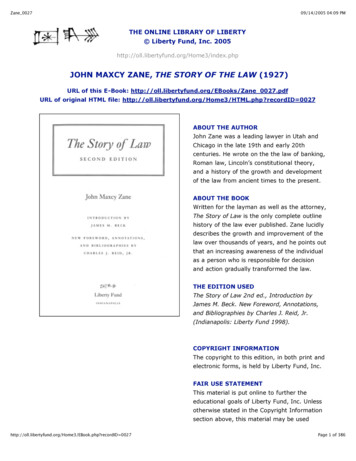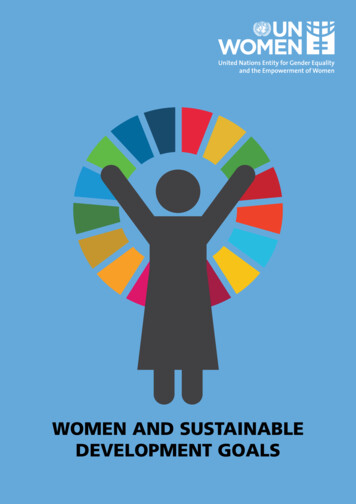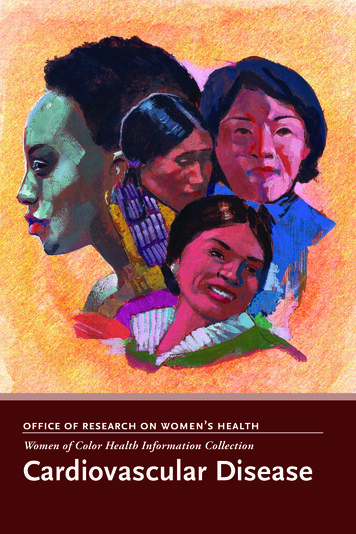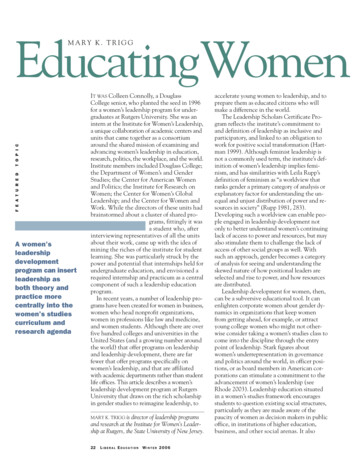
Transcription
WOMEN,BUSINESSAND THELAW 2020
WOMEN,BUSINESSAND THELAW 2020
2020 International Bank for Reconstruction and Development / The World Bank1818 H Street NW, Washington, DC 20433Telephone: 202-473-1000; Internet: www.worldbank.orgSome rights reserved1 2 3 4 23 22 21 20This work is a product of the staff of The World Bank with external contributions. The findings, interpretations, and conclusionsexpressed in this work do not necessarily reflect the views of The World Bank, its Board of Executive Directors, or the governments they represent. The World Bank does not guarantee the accuracy of the data included in this work. The boundaries,colors, denominations, and other information shown on any map in this work do not imply any judgment on the part of TheWorld Bank concerning the legal status of any territory or the endorsement or acceptance of such boundaries.Nothing herein shall constitute or be considered to be a limitation upon or waiver of the privileges and immunities of The WorldBank, all of which are specifically reserved.Rights and PermissionsThis work is available under the Creative Commons Attribution 3.0 IGO license (CC BY 3.0 IGO) http://creativecommons.org/licenses/by/3.0/igo. Under the Creative Commons Attribution license, you are free to copy, distribute, transmit, and adapt thiswork, including for commercial purposes, under the following conditions:Attribution—Please cite the work as follows: World Bank. 2020. Women, Business and the Law 2020. Women, Business andthe Law. Washington, DC: World Bank. doi:10.1596/978-1-4648-1532-4. License: Creative Commons Attribution CC BY 3.0IGOTranslations—If you create a translation of this work, please add the following disclaimer along with the attribution: Thistranslation was not created by The World Bank and should not be considered an official World Bank translation. The WorldBank shall not be liable for any content or error in this translation.Adaptations—If you create an adaptation of this work, please add the following disclaimer along with the attribution: Thisis an adaptation of an original work by The World Bank. Views and opinions expressed in the adaptation are the soleresponsibility of the author or authors of the adaptation and are not endorsed by The World Bank.Third-party content—The World Bank does not necessarily own each component of the content contained within the work.The World Bank therefore does not warrant that the use of any third-party-owned individual component or part containedin the work will not infringe on the rights of those third parties. The risk of claims resulting from such infringement restssolely with you. If you wish to re-use a component of the work, it is your responsibility to determine whether permission isneeded for that re-use and to obtain permission from the copyright owner. Examples of components can include, but arenot limited to, tables, figures, or images.All queries on rights and licenses should be addressed to World Bank Publications, The World Bank Group, 1818 H Street NW,Washington, DC 20433, USA; e-mail: pubrights@worldbank.org.ISBN (paper): 978-1-4648-1532-4ISBN (electronic): 978-1-4648-1533-1DOI: 10.1596/978-1-4648-1532-4Design: Takayo Fredericks and Fathom CreativeLibrary of Congress Control Number: 2020901241
CONTENTSCONTENTSiiForeword1Findings22Data Notes36Summaries of Reforms44Economy Data49AcknowledgmentsWomen, Business and the Law 2020is the sixth in a series of studies thatanalyze laws and regulations affecting women’s economic opportunity in190 economies.Eight indicators—structured aroundwomen’s interactions with the lawas they begin, progress through, andend their careers—align with the economic decisions women make at various stages of their lives. The indicatorsare Mobility, Workplace, Pay, Marriage,Parenthood, Entrepreneurship, Assets,and Pension.Data in Women, Business and the Law2020 are current as of September 1,2019. The indicators are used to buildevidence of the relationship betweenlegal gender equality and women’sentrepreneurship and employment.By examining the economic decisionswomen make as they go through different stages of their working lives,as well as the pace of reform overthe past two years, Women, Businessand the Law makes a contribution topolicy discussions about the state ofwomen’s economic opportunities.i
iiWOMEN, BUSINESS AND THE LAW 2020FOREWORDWomen, Business and the Law 2020 tracks how the law affects women at various stagesin their lives, from the basics of transportation to the challenges of starting a job andgetting a pension. This year’s study shows that progress is being made, with all regionsimproving their average scores.Still, the results are uneven — high-income countries tended to have the best scores,leaving women in many countries with only a fraction of the rights of men. That’s notacceptable. Women should be as free as men to travel. They should be paid the same asmen for work of equal value. They shouldn’t face gender discrimination when applyingfor a loan or starting a business, and they should have the same rights to property andinheritance as men.Legal rights for women are both the right thing to do and good from an economicperspective. Research shows clearly that reforms and policies that empower womenboost economic growth. When women can move more freely, work outside the home andmanage assets, they’re more likely to join the workforce and strengthen the economy.This year’s study has been expanded to cover the last 50 years. Over that period,important progress was made in closing the gender gap, as women increasingly enteredthe workforce and started businesses. The gains were especially dramatic in the abilityof women to start a job. Unfortunately, gender barriers persist, and laws and regulationscontinue to restrict women’s economic decision making and employment prospects.The study recognizes that creating good development outcomes is hard. Governmentscan use the Women, Business and the Law index to identify legal impediments to women’s economic opportunities. The latest study tracks legal equality between men andwomen in 190 economies. It’s important to note that Women, Business and the Lawmeasures only the formal laws and regulations governing women’s ability to work orown businesses — a country’s norms and practices aren’t captured by the indicators.There’s reason for optimism in this year’s study. Social mores are improving, andmany countries have improved the regulatory environment for women over the last twoyears. Among the 10 economies that advanced the most, nine are from the Middle East,North Africa, and Sub-Saharan Africa. Many of their efforts were focused in the areas ofstarting a job and working after having children. The result has been an improvement inwomen’s ability to enter the workforce and remain in it.Much work remains. We shouldn’t be satisfied until every young girl can movethrough her life without facing legal barriers to her success. At the World Bank Group,we stand ready to help.David R. MalpassPresidentThe World Bank Group
FINDINGSFINDINGS Better performance in the areas measured by the Women, Business andthe Law index is associated with more women in the labor force and withhigher income and improved development outcomes. Since 2017, 40 economies have enacted 62 reforms enhancinggender equality. The economies that improved the most are Saudi Arabia, the UnitedArab Emirates, Nepal, South Sudan, São Tomé and Príncipe, Bahrain, theDemocratic Republic of Congo, Djibouti, Jordan, and Tunisia. On average, women have just three-fourths of the legal rights affordedto men. With a recent reform to parental leave, Canada joins seven othereconomies that score 100 on the Women, Business and the Law index:Belgium, Denmark, France, Iceland, Latvia, Luxembourg, and Sweden.Binh lives and works in Vietnam. As a little girl, she liked science and studied hardto get good grades. Her parents were supportive and invested money in her education.The result: she became one of the first female forensic pathologists in her country. Butafter just a few years of work, she was prohibited from continuing at her job. A newdecree had labeled it an inappropriate job for women, forcing her employer to terminateher.All over the world, discriminatory laws continue to threaten women’s economicsecurity, career growth, and work–life balance. Such barriers to employment andentrepreneurship at every stage of life limit equality of opportunity, creating a businessenvironment that does not adequately support working women. In the Middle Eastand North Africa, women have only half the legal rights of men; worldwide, it is just 75percent. Although many economies have acted to reduce barriers to women’s economicparticipation over the last 50 years, the progress made cannot be equated with success.Women, Business and the Law emphasizes the work still to be done by making acontribution to research and policy discussions about the state of women’s economicopportunities. Since its inception in 2009, it has measured laws and regulations thatrestrict women’s economic inclusion.This year, the project explores the relationship between women’s empowerment andeconomic outcomes. Women, Business and the Law 2020 finds that over time, reformsincreasing women’s equality of opportunity contribute to more successful economies,higher female labor force participation, and better development outcomes. Over the lasttwo years, 40 economies from all regions and income groups have made women’s economic empowerment a priority by executing 62 reforms facilitating women’s entry into1
2WOMEN, BUSINESS AND THE LAW 2020the workforce. Such reforms allow governments to cultivate a business environmentthat benefits women entrepreneurs and employees, enhancing economic productivityand accelerating development.Measuring laws and regulationsTo demonstrate where laws facilitate or hinder women’s economic participation,Women, Business and the Law 2020 presents an index covering 190 economies andstructured around the life cycle of a working woman. To ensure comparability, thewoman in question is assumed to reside in the main business city of her economy andto be employed in the formal sector.Eight indicators constructed around women’s interactions with the law as theybegin, progress through, and end their careers are used to align different areas of thelaw with the economic decisions women make at various stages of their lives (figure1.1). The indicators were chosen based on statistically significant associations withoutcomes related to women’s economic empowerment, including women’s labor forceparticipation rates.The Mobility indicator, for example, assesses laws affecting women’s agency andfreedom of movement—two factors likely to influence their decision to enter the laborforce. Each subsequent indicator also looks at a specific set of regulations and the waysin which they affect women’s economic participation as entrepreneurs and employees.Policy makers interested in encouraging women to work can look at their economy’sscores for each indicator as a starting point for reform. This methodological approachbuilds on the experience of the World Bank’s Doing Business project, which developsobjective indicators of impediments to entrepreneurship and employment, by viewingsuch constraints through a gender lens.The Women, Business and the Law data set is constructed using laws and regulations that are currently in force. Unless they are codified, religious and customarylaws are not considered. Because the indicators serve as a basis for legal equality ofopportunity, implementation of laws is also not measured.In total, 35 questions are scored across the eight indicators (table 1.1). Overall scoresare then calculated by taking the average of each indicator, with 100 representing theFIGURE 1.1EIGHT INDICATORS MEASURE LEGAL DIFFERENCES BETWEEN MEN AND WOMEN AS THEY TRANSITIONTHROUGH DIFFERENT STAGES OF WORKING LIFEMobilityPayParenthoodAssetsExamines constraints onfreedom of movementMeasures laws and regulationsaffecting women’s payExamines laws affecting women’swork after having childrenConsiders gender differencesin property and inheritanceWorkplaceMarriageAnalyzes laws affectingwomen’s decisions to workAssesses legal constraintsrelated to marriageSource: Women, Business and the Law team.EntrepreneurshipAnalyzes constraints on women’sstarting and running businessesPensionAssesses laws affecting thesize of a woman’s pension
FINDINGSTABLE 1.1WHAT DOES THE WOMEN, BUSINESS AND THE LAW INDEX MEASURE?Mobility1.Can a woman choose where to live in the same way as a man?2.Can a woman travel outside her home in the same way as a man?3.Can a woman apply for a passport in the same way as a man?4.Can a woman travel outside the country in the same way as a man?Workplace1.Can a woman get a job in the same way as a man?2.Does the law prohibit discrimination in employment based on gender?3.Is there legislation on sexual harassment in employment?4.Are there criminal penalties or civil remedies for sexual harassment in employment?Pay1.Does the law mandate equal remuneration for work of equal value?2.Can women work the same night hours as men?3.Can women work in jobs deemed dangerous in the same way as men?4.Are women able to work in the same industries as men?Marriage1.Is there no legal provision that requires a married woman to obey her husband?2.Can a woman be head of household in the same way as a man?3.Is there legislation specifically addressing domestic violence?4.Can a woman obtain a judgment of divorce in the same way as a man?5.Does a woman have the same rights to remarry as a man?Parenthood1.Is paid leave of at least 14 weeks available to mothers?2.Does the government administer 100% of maternity leave benefits?3.Is paid leave available to fathers?4.Is there paid parental leave?5.Is dismissal of pregnant workers prohibited?Entrepreneurship1.Does the law prohibit discrimination in access to credit based on gender?2.Can a woman sign a contract in the same way as a man?3.Can a woman register a business in the same way as a man?4.Can a woman open a bank account in the same way as a man?Assets1.Do men and women have equal ownership rights to immovable property?2.Do sons and daughters have equal rights to inherit assets from their parents?3.Do female and male surviving spouses have equal rights to inherit assets?4.Does the law grant spouses equal administrative authority over assets during marriage?5.Does the law provide for the valuation of nonmonetary contributions?Pension1.Are the ages at which men and women can retire with full pension benefits equal?2.Are the ages at which men and women can retire with partial pension benefits equal?3.Are the mandatory retirement ages for men and women equal?4.Are periods of absence due to child care accounted for in pension benefits?Source: Women, Business and the Law database.3
4WOMEN, BUSINESS AND THE LAW 2020highest possible score. The resulting data set allows the index to function as an easilyreplicable way to benchmark the regulatory environment for women as entrepreneursand employees.As demonstrated over the last 10 years, the knowledge and analysis provided byWomen, Business and the Law make a strong economic case for laws that empowerwomen. The project demonstrates that equality before the law and of economic opportunity are not only wise social policy but also smart economic policy. Given the economic significance of women’s empowerment, the ultimate goal of Women, Businessand the Law is to encourage governments to reform laws that hold women back fromworking and doing business.Equality of opportunity is good economicsWomen, Business and the Law takes as its starting point that the equal participation ofwomen and men will give every economy a chance to achieve its potential. Equality ofopportunity allows women to make the choices that are best for them, their families,and their communities. It is also associated with improved economic outcomes.A significant body of research links reforms and policies aimed at achieving genderequality to women’s economic outcomes. For example, removing barriers that restrictthe ability of women to move freely, sign contracts, work outside the home, or manageassets has been associated with a more abundant female labor supply.1 In addition,fewer legal barriers are associated with access to better jobs for women, such as thoserequiring higher skill levels, offering higher wages, or presenting an opportunity tomanage others.2Reforming discriminatory laws captured by the Mobility and Entrepreneurshipindicators is also associated with higher levels of entrepreneurship and better access tofinance for women.3 Furthermore, raising the retirement age of women to match thatof men is correlated with an increased female labor supply, which should facilitate largerpensions and better financial security for women of retirement age.4Earlier evidence on the relationship between legal reforms and women’s economicoutcomes was generally limited to a certain number of economies, points in time, oraspects of the law. However, new research using Women, Business and the Law data—covering 50 years, 190 economies, and 35 aspects of the law—confirms that thesepositive relationships hold when studied on a global scale.5 Analysis shows that wherethe law ensures greater equality of economic opportunity between women and men,female labor force participation is higher. This result holds after taking into accountimportant factors—including income levels, fertility rates, and female education—andwhen using different statistical methods. The 50 years of Women, Business and the Lawdata also suggest a correlation between legal reform and a reduction of the wage gap(figure 1.2).It is not only women’s economic outcomes that improve with higher Women,Business and the Law index scores. Several studies also demonstrate that wherewomen and men are given equality of opportunity, positive development outcomesensue. Research shows that having fewer discriminatory laws and policies in placeresults in larger investments in health and education (both for women themselves andfor the next generation) and lower rates of sexually transmitted diseases.6 Such results
FINDINGSFIGURE 1.2 W HERE THE WOMEN, BUSINESS AND THE LAW INDEX SHOWS GREATER EQUALITY, FEMALE LABORFORCE PARTICIPATION RATES ARE HIGHER AND THE WAGE GAP BETWEEN WOMEN AND MEN ISLOWERb. Wage gap29.6045.70Gender wage gap (percent)Female labor force participation (percent)a. Female labor force participation36.8031.3426.6720.651st quintile (worst)2nd quintile3rd quintileWBL index4th quintile5th quintile (best)20.0115.7116.371st quintile (worst)2nd quintile3rd quintile4th quintile15.245th quintile (best)WBL indexSources: Panel a: Women, Business and the Law (WBL) database; World Development Indicators (WDI) database. Panel b: Women, Business and the Law (WBL) database; WorldDevelopment Indicators (WDI) database; ILOSTAT; OECD.Stat.Note: Panel a: The relationship between the WBL index and female labor force participation is statistically significant after controlling for income (measured as GDP per capita provided in theWDI database), fertility rates, industrial composition, female education, the male working-age population, and economy-level and time fixed effects. Regression of female labor force participationon the WBL index includes 176 economies for the period 1991–2018, as determined by data availability. This statistical relationship should not be interpreted as causal. For full results of theempirical analysis of the relationship between WBL scores and women’s economic outcomes, see Hyland, Djankov, and Goldberg (2019). Panel b: The relationship between the WBL index and thegender wage gap is statistically significant after controlling for income (measured as GDP per capita provided in the WDI database), fertility rates, industrial composition, female education, themale working-age population, and economy-level and time fixed effects. Regression of the gender wage gap on the WBL index includes 68 economies for the period 1973–2017, as determinedby data availability. The gender wage gap represents the ratio of male to female earnings. This statistical relationship should not be interpreted as causal.suggest that giving women more economic rights strengthens their bargaining powerwithin the household, resulting in better outcomes not only for themselves but also fortheir children and families.7Correlating Women, Business and the Law data with development outcomes alsoreveals that in economies where women have greater economic opportunity, there arelower rates of maternal mortality and higher levels of female education.8 These positivedevelopment outcomes may stem, at least in part, from improved economic outcomesbenefiting women when the legal playing field is more level.9Findings such as these extend to entire economies as well. Several studies showthat inequality between women and men can harm economic growth. For example,one study found that without the increase in female labor force participation between1890 and 1980 in the United States, income per capita could have been as much as14 percent below its actual level.10 More recent research confirmed this link betweenfemale labor supply and growth in other contexts.11 Inequality in education, in humancapital more broadly, and in wage rates has also been tied to negative consequences forthe wider economy.12 Indeed, suggestive evidence of the positive relationship betweengender equality and development is illustrated by a simple correlation between Women,Business and the Law index scores and income per capita.5
WOMEN, BUSINESS AND THE LAW 2020By developing a time series and further researching the interaction between inequality of opportunity for women and labor market dynamics, Women, Business and theLaw strengthens insights into how women’s employment and entrepreneurship areaffected by legal gender discrimination, and in turn how this affects economic outcomes. Analysis based on the time series finds that at the global level, discriminationmatters.13 Identifying where gaps remain furthers this exploration of progress towardgender equality and economic development.Insights from new dataBased on a review of reforms since 2017, Women, Business and the Law 2020 updatesthe index presented in its 2019 study, A Decade of Reform. In 2019, the average globalscore is 75.2, up from 73.9 as measured in 2017. Eight economies—Belgium, Canada,Denmark, France, Iceland, Latvia, Luxembourg, and Sweden—score 100, meaning thatwomen are on an equal legal standing with men across all eight indicators (table 1.2).Of the 40 economies with scores higher than 90, 27 are Organisation for EconomicCo-operation and Development (OECD) high-income economies and nine are in Europeand Central Asia. The remaining four are in Latin America and the Caribbean, East Asiaand the Pacific, and Sub-Saharan Africa. No economy in the Middle East and NorthAfrica or South Asia scores higher than 90.Regional distribution patterns have remained unchanged since 2017. OECD highincome economies score the highest, followed by the Europe and Central Asia, LatinAmerica and the Caribbean, and East Asia and the Pacific regions. Economies in SubSaharan Africa have an average regional score of 69.9, while economies in South Asiascore 62.3 on average. Economies in the Middle East and North Africa have the lowestaverage score, 49.6. While all regions improved their scores on average, it was thelowest-scoring regions that made the most progress toward gender equality over thelast two years (figure 1.3).FIGURE 1.3 R EGIONS WITH THE LOWEST WOMEN, BUSINESS AND THE LAW SCORES MADE THE MOSTPROGRESS TOWARD EQUALITY10094.094.683.8WBL .9High income: OECDEurope & Central AsiaLatin America & CaribbeanEast Asia & Pacific2017Source: Women, Business and the Law database.Sub-Saharan Africa2019South Asia49.6Middle East & North Africa
FINDINGSTABLE 1.2WOMEN, BUSINESS AND THE LAW 2020 ninScore74.4Papua New Guinea60.0Canada100.0Romania90.6Bahamas, The81.3Gambia, The74.4Niger59.4Denmark100.0Ecuador89.4Puerto Rico81.3India74.4Comoros58.8France100.0Hong Kong SAR, China89.4Zambia81.3Maldives73.8Marshall Islands58.8Iceland100.0El .8Sweden100.0Lao PDR88.1Malawi80.6Russian Federation73.1Vanuatu58.1Estonia97.5South Africa88.1Costa e86.9San Marino80.0Bhutan71.9Cameroon56.9Greece97.5Cabo Verde86.3Belize79.4Ethiopia71.9Solomon Islands56.9Ireland97.5Dominican Republic86.3Burkina Faso79.4Madagascar71.9United Arab Emirates56.3Italy97.5Namibia86.3Fiji79.4Central African Republic71.3Brunei .4St. Kitts and Nevis71.3Lebanon52.5Portugal97.5São Tomé and Príncipe86.3Azerbaijan78.8Guatemala70.6Equatorial Guinea51.9Spain97.5Georgia85.6Congo, Dem. Rep.78.8Saudi Arabia70.6Libya50.0United Kingdom97.5Switzerland85.6Kiribati78.8South Sudan70.0Malaysia50.0Australia96.9Bosnia and 49.4Hungary96.9Korea, .9North u95.0Venezuela, oldova84.4Thailand78.1Sri Lanka68.1Congo, Rep.46.3New Zealand94.4Tanzania84.4Chile77.5St. Vincent and the el77.5Uzbekistan67.5Mauritania45.6Slovak Republic94.4Liberia83.8Barbados76.9Antigua and Barbuda66.3Egypt, Arab Rep.45.0Croatia93.8Mexico83.8Kyrgyz Republic76.9Chad66.3Iraq45.0Czech Republic93.8St. .5Lithuania93.8Côte negal63.8Syrian Arab 5.6Sierra 0Dominica62.5Iran, Islamic n29.4Taiwan, China91.3Colombia81.9Honduras75.0Micronesia, Fed. Sts.61.3Yemen, Rep.26.9United States91.3Japan81.9Trinidad and Tobago75.0Mali60.6West Bank and Gaza26.3Source: Women, Business and the Law database.7
8WOMEN, BUSINESS AND THE LAW 2020When classified by income level, high-income economies score the highest, withan average score of 84.9. Upper-middle-income economies are not far behind, scoring74.9 on average. Lower-middle- and low-income economies have similar average scoresof 68.8 and 67.2, respectively. However, one noteworthy finding is that low-incomeeconomies outperform both middle-income groups on the Workplace and Pensionindicators. One reason for this could be the introduction of new labor codes in theseeconomies after conflict or independence.The data also indicate that retirement ages are more equal between women andmen in lower-income economies. Unequal retirement ages can leave women withsmaller pensions in old age. A push for greater fiscal sustainability has driven manyeconomies to change laws in this area because women tend to live longer, but oftenretire earlier, than men.Of the indicators, the one with the most room to improve is Parenthood, where theaverage score is just 53.9. In other words, about half of the economies measured byWomen, Business and the Law do not have the good practices identified by this indicator. For example, 115 economies guarantee paid maternity leave of 14 weeks or more.However, in almost 50 percent of economies that provide any form of paid maternityleave, the burden falls fully or partially on the employer, making hiring women morecostly than hiring men. However, the provision of paid maternity leave can improvethe retention of female employees, reducing turnover cost and improving productivity,which can generate returns for employers that outweigh any short-term costs.14While more than half of the economies covered mandate paid leave specificallyreserved for fathers, the median duration of that leave is just five days (figure 1.4). Only43 economies have paid parental leave that can be shared by mothers and fathers. In2019, the European Union (EU) passed a new directive aimed at increasing the amountof leave available to both parents and redistributing child care responsibilities betweenwomen and men. EU states now have three years to adopt legislation complying withECAOECDLACFIGURE 1.4 MEDIAN LENGTH OF PAID LEAVE BY REGIONMaternity leavePaternity leaveEast Asia& PacificEurope &Central AsiaHigh tin America& Caribbean91DAYS5DAYSMENAMiddle East& North Africa70DAYS3DAYSSASouth AYSDAYS985Source: Women, Business and the Law database.Note: Maternity leave refers to the sum of paid maternity leave and paid parental leave, excluding any paid parental leave specifically reserved for fathers. Paternity leave refers to the sum ofpaid paternity leave and any paid parental leave specifically reserved for fathers. Of the economies covered, 184 guarantee at least one day of maternity leave, and 105 guarantee at least oneday of paternity leave.
FINDINGSthe directive. Because of this advance, Women, Business and the Law expects morereforms in this area among the top-scoring economies.Another indicator area in which there is room to improve is Pay. Ninety economiesstill have at least one restriction on the jobs women can hold (table 1.3). However,in Europe and
FINDINGS 1 er performance in the areas measured by the Bett Women, Business and the Law index is associated with more women in the labor force and with higher income and improved development outcomes. Since 2017, 40 economies have enacted 62 reforms enhancing gender equality. The economies that improv










